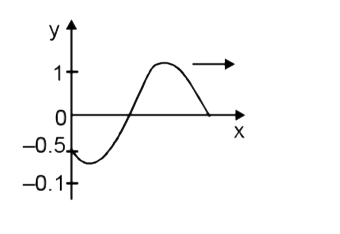In the figure shown a sinusoidal wave is generated at the end 'A'. The wave travels along positive x−axis and during its motions it encounter another string BC at the junction 'B' at x=0. The density of strings AB and BC and ρ and 9ρ respectively and their radii of cross sections are 2r and r. The wave funcation. amplitude and wavelength of incident wavs are respectively yr,Ar,λr and yt,At,λt repectively

Which of the following statement regarding phase difference, Δϕ between waves at x=0 is true ?
Δϕ=0, between yi and yr
Δϕ=0, between yr and yt
Δϕ=π, between yi and yt
Δϕ=π, between yt and yt
The correct Answer is:D
Medium of string BC is denser. These will be π phase difference between reflected and transmitted wave.
λrλt=v1v2=√μ2μ1
Now μ1μ2=49 so λrλt=32
ArAt=v2−v1v1+v2Ai2v2v1+v2.Ai=v2−v12v2=14
Topper's Solved these Questions
- TRAVELLING WAVESBook:RESONANCEChapter:TRAVELLING WAVESExercise:Exercise- 3 PART I
Explore 19 Videos
- TRAVELLING WAVESBook:RESONANCEChapter:TRAVELLING WAVESExercise:Exercise- 3 PART II
Explore 7 Videos
- TRAVELLING WAVESBook:RESONANCEChapter:TRAVELLING WAVESExercise:Exercise- 2 PART III
Explore 15 Videos
- TEST SERIESBook:RESONANCEChapter:TEST SERIESExercise:PHYSICS
Explore 127 Videos
- WAVE ON STRING Book:RESONANCEChapter:WAVE ON STRING Exercise:Exercise- 3 PART I
Explore 19 Videos
Similar Questions
Knowledge Check
In the figure shown a sinusoidal wave is generated at the end 'A'. The wave travels along positive x−axis and during its motions it encounter another string BC at the junction 'B' at x=0. The density of strings AB and BC and ρ and 9ρ respectively and their radii of cross sections are 2r and r. The wave funcation. amplitude and wavelength of incident wavs are respectively yr,Ar,λr and yt,At,λt repectively

The ratio of amplitudes Ar to At is (i.e. A_(r) : A_(t)) will beA1:1B1:4C4:1DNone of theseIn the figure shown a sinusoidal wave is generated at the end 'A'. The wave travels along positive x−axis and during its motions it encounter another string BC at the junction 'B' at x=0. The density of strings AB and BC and ρ and 9ρ respectively and their radii of cross sections are 2r and r. The wave funcation. amplitude and wavelength of incident wavs are respectively yr,Ar,λr and yt,At,λt repectively

The ratio of amplitudes Ar to At is (i.e. A_(r) : A_(t)) will beA1:1B1:4C4:1DNone of theseIn the figure shown a sinusoidal wave is generated at the end 'A'. The wave travels along positive x−axis and during its motions it encounter another string BC at the junction 'B' at x=0. The density of strings AB and BC and ρ and 9ρ respectively and their radii of cross sections are 2r and r. The wave funcation. amplitude and wavelength of incident wavs are respectively yr,Ar,λr and yt,At,λt repectively

The ratio of wavelengths λr to λt (i.e. λr:λt) will beA1:1B3:2C2:3DNone of these
In the figure shown a sinusoidal wave is generated at the end 'A'. The wave travels along positive x−axis and during its motions it encounter another string BC at the junction 'B' at x=0. The density of strings AB and BC and ρ and 9ρ respectively and their radii of cross sections are 2r and r. The wave funcation. amplitude and wavelength of incident wavs are respectively yr,Ar,λr and yt,At,λt repectively

The ratio of wavelengths λr to λt (i.e. λr:λt) will be
View SolutionIn the figure shown a sinusoidal wave is generated at the end A the wave travels along positive x-axis and during its motion it encounter another string BD at the junction 'B'atx=0.The density of string AB and BC are ρand9ρrespectively and their radii of cross sections are 2randr. The wave function amplitude and wavelength of incident wave are respectively ypAiandλr Similarly for reflected and transmitted wave these peremeters are yr,Ar,λrandyi,Ai,λi

Which of the following statement regarding phase difference Δϕ between waves at x=0 is true?
View SolutionIn the figure shown a sinusoidal wave is generated at the end A the wave travels along positive x-axis and during its motion it encounter another string BD at the junction 'B'atx=0.The density of string AB and BC are ρand9ρrespectively and their radii of cross sections are 2randr. The wave function amplitude and wavelength of incident wave are respectively ypAiandλr Similarly for reflected and transmitted wave these peremeters are yr,Ar,λrandyi,Ai,λi

The ratio of amplitudes ArtoAris(i.e.Ar:At) will be
View SolutionIn the figure shown a sinusoidal wave is generated at the end A the wave travels along positive x-axis and during its motion it encounter another string BD at the junction 'B'atx=0.The density of string AB and BC are ρand9ρrespectively and their radii of cross sections are 2randr. The wave function amplitude and wavelength of incident wave are respectively ypAiandλr Similarly for reflected and transmitted wave these peremeters are yr,Ar,λrandyi,Ai,λi

The ratio of wavelengths λrtoλi(i.e.λr:λt) will be
View SolutionThe equation of a wave travelling along the positive x-axis, as shown in figure at t=0 is given by :-
_E01_059_Q01.png) .
.
View Solution


